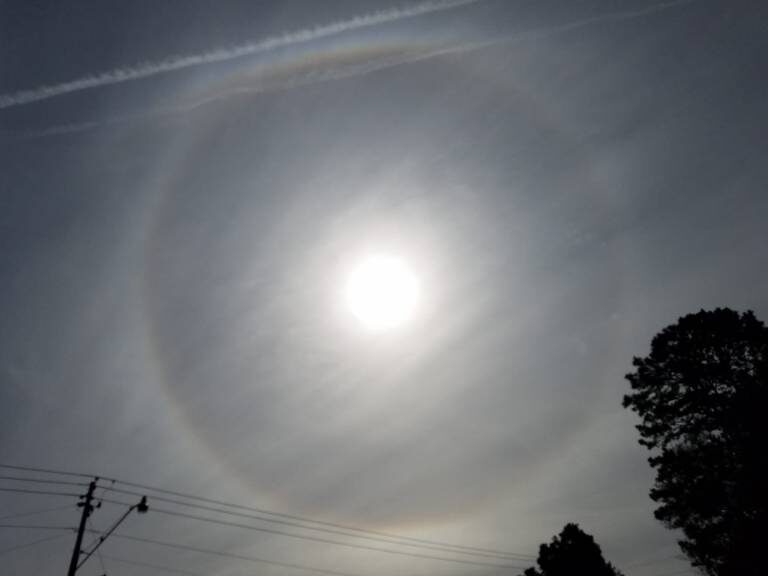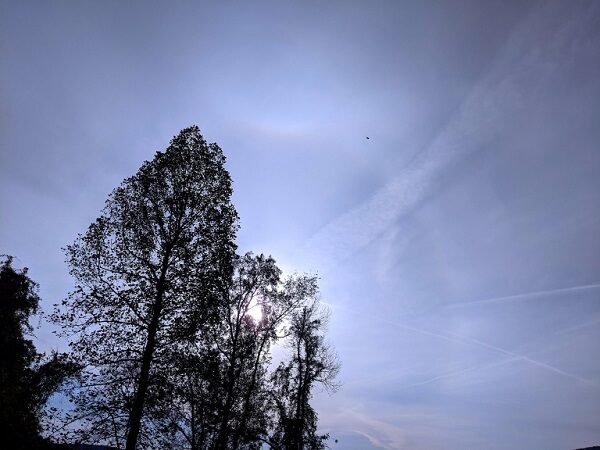
© Michelle MiklikSun dog with upper and lower tangental arcs above and below the sun.
Michelle Miklik spotted this in the sky over Weaver, Alabama Wednesday afternoon. Did you see something similar?
Sun dog with upper and lower tangental arcs above and below the sun. Photo: Michelle Miklik
If you did, you spotted an atmospheric optical phenomenon known as a 22-degree halo.
What are sun halos?Earthsky.org explains it very simply: "Halos are a sign of high thin cirrus clouds drifting 20,000 feet or more above our heads."
"These clouds contain millions of tiny ice crystals. The halos you see are caused by both refraction, or splitting of light, and also by reflection, or glints of light from these ice crystals."
It is called a 22-degree halo because the ring has a radius of approximately 22 degrees around the sun or moon.

© Ramona Edwards
According to the site
Atmospheric Optics, the halo remains the same diameter no matter what position the sun is found in the sky.
At times, portions of the circle may be missing, so only a segment can be seen.
The high, thin cirrus clouds creating the sun halo usually arrive ahead of weather systems that bring our next chance of rain. However, the frontal system responsible for today's clouds is very weak, and no rain is expected for the next few days.
What are tangental arcs?According to
Atmospheric Optics, tangent arcs form "when cirrus clouds have well developed
columnar ice crystals drifting with their long axes almost horizontal. These are called "
singly oriented columns" because having their long axes horizontal is their only orientation constraint. They can take up any rotational position around their long axis and a vertical axis. This crystal
orientation is a common one and produces a number of different halos."
"The rays of tangent arcs enter a side face and leave directly through another inclined 60º to the first. As in the rays forming the
22º halo, a deflection of 22º after the two refractions is the angle of
minimum deviation but larger ray deviations occur as well. Thus the tangent arcs touch the 22º halo but rays deviated through larger angles (including skew rays) form its 'wings'."
Tangental arcs are often seen at the same time as sun halos and sun dogs. What makes the former different from the later is the orientation of the ice crystals.
What are sundogs? How do they form?Near sunset, the sun halo will also feature two "faux suns" on each side of the real sun — these are known as sun dogs!
Sundogs are a form of atmospheric optics that occur when the sun's rays pass through ice crystals high in the atmosphere. The ice crystals indicate that moisture is present in the atmosphere, well above the freezing layer.
In the case of sundogs, the ice crystals are oriented in such a way that their large faces are parallel with the ground. This allows sunlight to pass through one of the edges, when it then refracts (or bends). The refraction is occurs at 60 degrees from the edge of the crystal, or 20 degrees from the original path of the sun's ray if it hadn't entered the crystal.
The sunlight travels through the crystal and exits out of a different edge, refracting once again. Red light refracts a little more than the blue light, so you see the reddish hue closer towards the sun.
It takes more than one ice crystal to produce a sundog. In fact, the phenomenon that you see occurs because many crystals are present and their sunlight is being directed back to your eyes.
Sun halos and sun dogs can be seen when thin, wispy cirrus clouds are present in the sky. These clouds are often present a few days before an on-coming storm system, or even behind a departing storm system.
If you were able to capture this beautiful phenomena, send us a photo.
Reader Comments
to our Newsletter